Gigabyte GA-X79-UD3 Review
by Ian Cutress on December 26, 2011 4:37 PM EST- Posted in
- Motherboards
- Gigabyte
- X79
- Sandy Bridge E
USB Speed
For this benchmark, we run CrystalDiskMark to determine the ideal sequential read and write speeds for the USB port using our 64GB Patriot SuperSpeed USB 3.0 drive. Then we transfer a set size of files from the SSD to the USB drive, and monitor the time taken to transfer. The files transferred are a 1.52 GB set of 2867 files across 320 folders – 95% of these files are small typical website files, and the rest (90% of the size) are the videos used in the Sorenson Squeeze test.
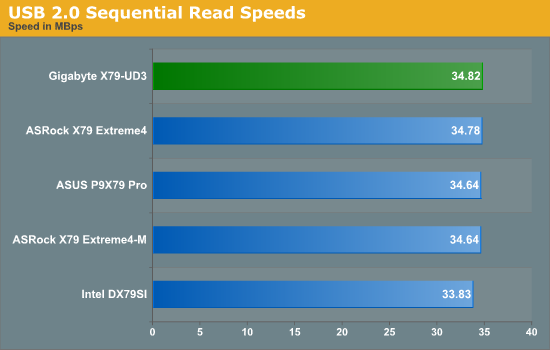
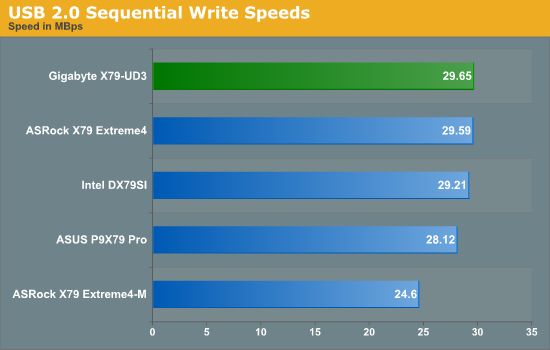
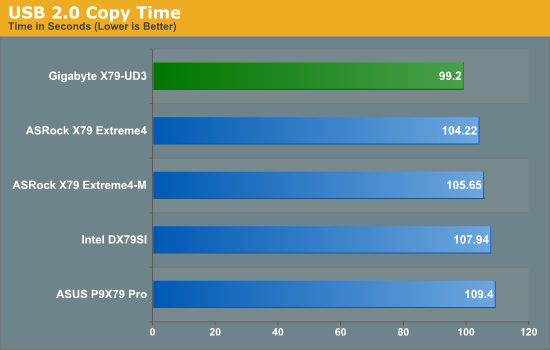
By default, one of the Gigabyte's best showings is in the USB 2.0 tests. It comprehensively is ahead, especially in the USB copy test. Unfortunately, with my USB 3.0 device and the Gigabyte's USB 3.0 Fresco controller, there were compatibility issues preventing any USB 3.0 testing. Should we get a driver update, we will update the graphs.
SATA Testing
We also use CrystalDiskMark for SATA port testing. The operating system is installed on the SSD, and the sequential test is run at the 5 x 1000 MB level. This test probes the efficiency of the data delivery system between the chipset and the drive, or in the case of additional SATA ports provided by a third party controller, the efficiency between the controller, the chipset and the drive.
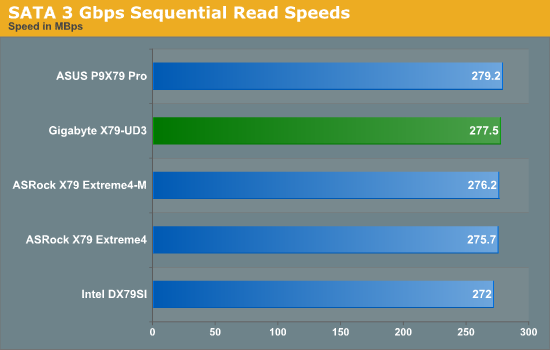
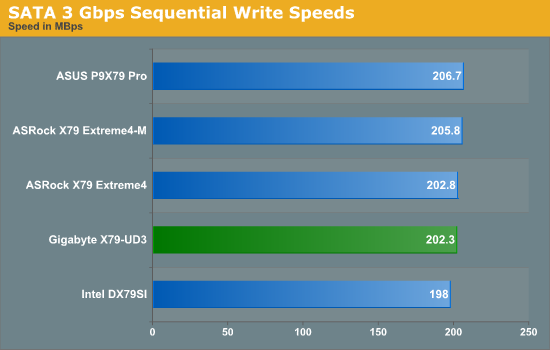
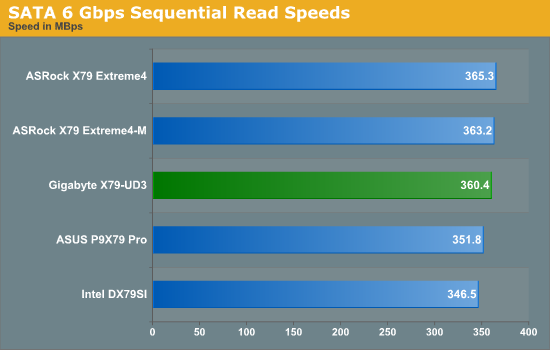
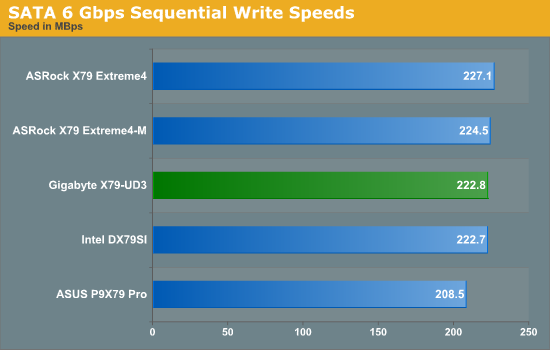
SATA testing of the PCH ports reveals nothing special, with the Gigabyte UD3 being in the middle of the road on average.
DPC Latency
Deferred Procedure Call latency is a way in which Windows handles interrupt servicing. In order to wait for a processor to acknowledge the request, the system will queue all interrupt requests by priority. Critical interrupts will be handled as soon as possible, whereas lesser priority requests, such as audio, will be further down the line. So if the audio device requires data, it will have to wait until the request is processed before the buffer is filled. If the device drivers of higher priority components in a system are poorly implemented, this can cause delays in request scheduling and process time, resulting in an empty audio buffer – this leads to characteristic audible pauses, pops and clicks. Having a bigger buffer and correctly implemented system drivers obviously helps in this regard. The DPC latency checker measures how much time is processing DPCs from driver invocation – the lower the value will result in better audio transfer at smaller buffer sizes. Results are measured in microseconds and taken as the peak latency while cycling through a series of short HD videos - under 500 microseconds usually gets the green light, but the lower the better.
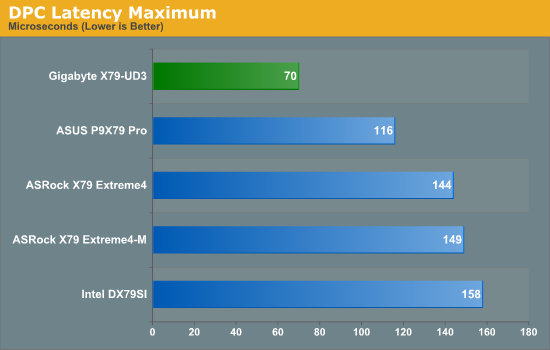
By far one of the best results we had with the Gigabyte board is the DPC testing, where it beat our previous best (an ASUS P8P67) by 25+ microseconds. Getting a score of 70 microseconds is indicative of very clever driver and BIOS programming. However, as with many boards we've seen for X79, to get this result, any voltage/fan monitoring software must be turned off - in this case, EasyTune6.










39 Comments
View All Comments
MadMan007 - Monday, December 26, 2011 - link
There are other ways to implement fan control than PWM though, namely voltage control which works with any fan even 2-pin ones with no RPM sensor plus all the 3-pin aftermarket fans. Even if all it did was allow for altrered voltage, or simple software with manual profiles (ie: 'quiet' at a certain voltage' and 'high performance' at another voltage) it would be a big step up from no fan control. Of course that probably costs about $1 in additional parts so god forbid many motherboards have that.In the end it just means having to stick with a real manual fan control but it would be nice to see on motherboards.
gevorg - Wednesday, December 28, 2011 - link
True but not all mobo manufacturers are as cheap as Gigabyte in this regard. Basic P67/Z68 mobos from Intel and Asus/ASRock have case fan controls and some even by PWM.Andrea deluxe - Tuesday, December 27, 2011 - link
http://www.techpowerup.com/157543/Gigabyte-Recalli...Andrea deluxe - Tuesday, December 27, 2011 - link
http://www.youtube.com/watch?v=J_Wk4QWHjpcBrandenburgh Man - Tuesday, December 27, 2011 - link
It's silly to criticize Gigabyte's Multi-Threaded 3D Particle Movement score when the difference between Gigabyte's score of 898.96 and the highest score of 914.36 is less than 2 percent. In the real world, anything less than a 10 percent performance difference is unnoticeable by the user. Typically you have to get 20 to 25 percent better performance before it becomes meaningful to you, and 33 percent or better before you start getting excited about it.wifiwolf - Tuesday, December 27, 2011 - link
If you mean motherboard performance benchmarks are by far less meaningful i agree.That's because this is the less significant part in your system performance-wise, which means 2% difference overall is enough to say it's too much for an high-end.
cactusdog - Tuesday, December 27, 2011 - link
Gigabyte has recalled this board because of a too weak VRM that alows mosfets to explode when overclocking,UD3/ UD5, A1 Assassin all RECALLED by Gigabyte
rumblpak - Tuesday, December 27, 2011 - link
Shouldn't you note that they've all been recalled? Gigabyte announced a worldwide recall of all of their X79 boards.surt - Tuesday, December 27, 2011 - link
Who is buying an x79 and only getting 4 memory slots anyway? That's just crazy. If you want this platform at all, you surely want the large amount of memory it can support. If for nothing else, you can run a nice ramdisk and get things running 10x faster than the best SSD you can buy.Brandenburgh Man - Tuesday, December 27, 2011 - link
I thoroughly agree. SSDs are great for fast boot times and fast program loads, but when you really need *superfast* access to data, nothing beats a RAM drive.Although 4GB DDR3 sticks are dirt cheap right now, four memory slots only comes to 16GB. A six-core hyper-threaded Sandy Bridge E chip would quickly exhaust that if you're a power user who does a lot of video editing or transcoding while simultaneously running other programs. Even if you can afford the currently very expensive 8GB DDR3 sticks, 32GB isn't anything to brag about for a workstation class computer. Better to get a mobo with 8 slots and populate it with 32GB now, then upgrade to 64GB a year or so later when 8GB sticks becine more affordable. Then you'd have the best of both worlds, a huge RAM-disk for incredibly fast I/O, with enough system RAM left over to keep the CPU from being starved.
A few years ago Jerry Pournelle said we were entering the age of computational plenty. I like to say we're entering the age of desktop supercomputing. The future looks very bright indeed.